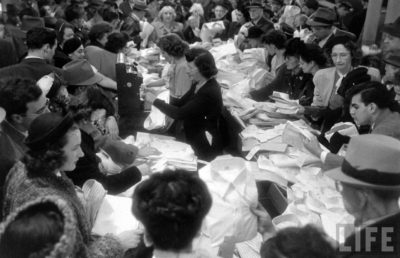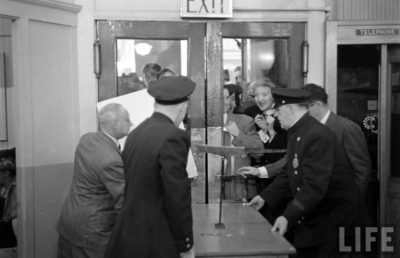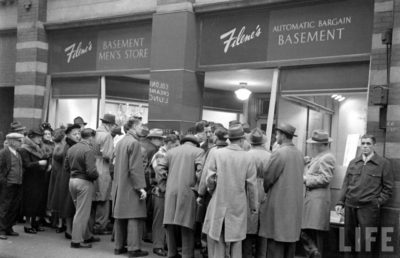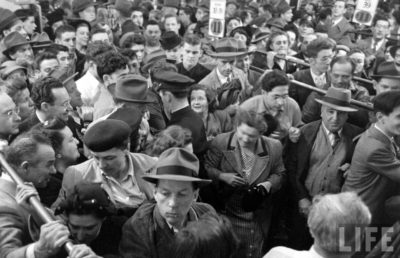 Consider the salesgirl. This holiday season, as we navigate the nation’s retail theatre in stores and online, let’s think about the ideas and ideologies of the diverse Americans at work behind the counter. Hero or villain, peddler or pauper, capitalist superhero or covert anarchist: the figure of the salesman has trod through American fiction for more than two centuries. Authors have used the man-as-market metaphor to interpret large-scale economic change and industrialization. Writers have drawn on the idea of salesgirls-as-species to reconsider gender roles and business ethics. Long before Willy Loman, salespeople supplied our demand to make market “selves.”
Consider the salesgirl. This holiday season, as we navigate the nation’s retail theatre in stores and online, let’s think about the ideas and ideologies of the diverse Americans at work behind the counter. Hero or villain, peddler or pauper, capitalist superhero or covert anarchist: the figure of the salesman has trod through American fiction for more than two centuries. Authors have used the man-as-market metaphor to interpret large-scale economic change and industrialization. Writers have drawn on the idea of salesgirls-as-species to reconsider gender roles and business ethics. Long before Willy Loman, salespeople supplied our demand to make market “selves.”
 Getting at the myth of the salesman and how it mirrors our “fables of abundance” in the sphere of fiction provides a useful imaginary to trace real-world revolutions. In any era, novels can help us investigate the question of what constitutes “American” character. The paradoxical nature of a sales job—to be all things to all people—forces real and fictional salespeople alike, to, as Guy Oakes observes, “develop the hardened sensibilities and iron-clad defenses of the trench fighter at the same time that they cultivate the emotional virtuosity of the courtier.” I second this as true, based on my decade+ of full-time work in retail. Here is a sample of the related books I read to transition from that career to a new path in American history; I wanted to know the history of the intellectual category that I carried, for better or worse, into the classroom. For scholars interested in using literature to decode the history of capitalism, I offer fiction exploring how salespeople have traveled through myth and memory. Your recommendations are welcome in the comments.
Getting at the myth of the salesman and how it mirrors our “fables of abundance” in the sphere of fiction provides a useful imaginary to trace real-world revolutions. In any era, novels can help us investigate the question of what constitutes “American” character. The paradoxical nature of a sales job—to be all things to all people—forces real and fictional salespeople alike, to, as Guy Oakes observes, “develop the hardened sensibilities and iron-clad defenses of the trench fighter at the same time that they cultivate the emotional virtuosity of the courtier.” I second this as true, based on my decade+ of full-time work in retail. Here is a sample of the related books I read to transition from that career to a new path in American history; I wanted to know the history of the intellectual category that I carried, for better or worse, into the classroom. For scholars interested in using literature to decode the history of capitalism, I offer fiction exploring how salespeople have traveled through myth and memory. Your recommendations are welcome in the comments.
- Herman Melville, The Confidence Man: His Masquerade (1857): A shipboard charlatan who is a chameleon of race and class, Melville’s protagonist succeeds at philanthropic scams and fake investments. His ship of fools is just as fascinating, though—a way for the author to sketch contemporary attitudes toward Native Americans, gentlemen scholars, and tipsy speculators. The salesman plays as hero and anti-hero, an Old World peddler fine-tuning his pitch for the railroad and steamboat crowd. By novel’s end, as he pours out cheap champagne and patchwork philosophy, it’s clear that he and his marks are in “it” (modernity?) together. The idea that a salesman and his clients act as a lifelong ensemble weathering cultural turns also steers Daniel Wallace’s Big Fish (1998).
- Mark Twain and Charles Dudley Warner, The Gilded Age: A Tale of Irony (1873): Here’s a syllabus staple, thanks to the authors’ snappy and sharp characterization of, well, an age. Chronicling America’s fateful love of luxury and politics, there’s also a commodities shift happening here, as heavy catalogues of new products took traveling salesmen off the open road and gave rise to department stores largely run by women. Within a few decades, big corporations tapped the children of the Gilded Age to serve as “sales engineers.” Soaked in acquiring stuff, what moral price did we pay? For an excellent contrast, jump ahead to William Inge’s play, The Dark at the Top of the Stairs (1957). Yoked to a dying commercial enterprise, harness salesman Ruben Flood must contend with a consumption-addicted family and a corps of younger, aggressive colleagues. To his wife, Flood laments the state of American consumer society: “Times are changin, Cora, and I dunno where they’re goin’. I’m a stranger in the very land I was born in.” For more on masculinity and retail in the American Century, there’s always Sinclair Lewis’ Babbitt (1922), Eugene O’Neill’s The Iceman Cometh (1946), and Arthur Miller’s Death of a Salesman (1949). But let’s move along and feature a few lesser known works next…
 Comradeship and competition within the workplace changed women’s cultural perceptions while they continued to exert buying power as a form of economic citizenship. By the 1920’s and 1930’s, the American retail landscape was dotted with palatial department stores where women shopped and sold. Take a look at a 1949 Life Magazine shoot, shown here, documenting the cultural power of a place like Filene’s in Boston. Scientists took note. In her 1929 study, The Saleslady, sociologist Frances R. Donovan went looking for saleswomen who mirrored the plucky heroines in, say, Edna Ferber’s tart vignettes.
Comradeship and competition within the workplace changed women’s cultural perceptions while they continued to exert buying power as a form of economic citizenship. By the 1920’s and 1930’s, the American retail landscape was dotted with palatial department stores where women shopped and sold. Take a look at a 1949 Life Magazine shoot, shown here, documenting the cultural power of a place like Filene’s in Boston. Scientists took note. In her 1929 study, The Saleslady, sociologist Frances R. Donovan went looking for saleswomen who mirrored the plucky heroines in, say, Edna Ferber’s tart vignettes.
 Donovan underlined that real saleswomen enjoyed steady paychecks, employee discounts, and better apartments than the average secretary. The job welcomed singles, who sometimes won junior managerial positions or married that rare millionaire client. Paramount in Donovan’s romanticized account of retail life was the energizing effect of professional camaraderie; her protoype of a saleswoman relied on the kindness of strangers, as well as a colorful train of coworkers stretching from stockroom to register. “Like soldiers in the trenches,” Donovan wrote, “they are buddies.”
Donovan underlined that real saleswomen enjoyed steady paychecks, employee discounts, and better apartments than the average secretary. The job welcomed singles, who sometimes won junior managerial positions or married that rare millionaire client. Paramount in Donovan’s romanticized account of retail life was the energizing effect of professional camaraderie; her protoype of a saleswoman relied on the kindness of strangers, as well as a colorful train of coworkers stretching from stockroom to register. “Like soldiers in the trenches,” Donovan wrote, “they are buddies.” - Dorothy Canfield Fisher, The Home-Maker (1924): That kinship, novelists thought, attracted women who felt tethered to outmoded domestic roles. For Fisher’s desperate housewife, Evangeline Knapp, a sudden decision to work retail has a palliative effect. It relieves her of a “profound depression” over housework and restores her self-esteem. There’s a lot to wind through in this short piece of literature—female fury over domestic “bliss,” the role of woman as protector of market populism—so it’s worth a read. A good contrast comes with Steve Martin’s Shopgirl (2000), a melancholy portrait of a luxury saleswoman’s private life. Here, at the other end of Fisher’s century, the department store lies dormant. Martin’s star, Mirabelle Butterfield, totters gingerly through it in sky-high heels: “Everyone is silent at Neimans, as thought it were a religious site,” Martin writes.
- Eudora Welty, “Death of a Traveling Salesman” (1941): If you teach U.S. intellectual history, DO assign anything by Welty, mainly for her sharp eye on modernizing America. This short story follows R.J. Bowman, a 14-year veteran of door-to-door shoe sales, with grim detachment. Mid-sale, Bowman senses the first pangs of heart failure and can only conclude that it was “a shock…to feel his heart beating at all.” Stark prose, plain plot: These are Welty’s writing guides as she measures out the moments of Bowman’s life. Welty’s rural sketch offers an interesting prequel to the literary fruits of the following decades. For example, salespeople and suburban inertia are a toxic mix in Philip K. Dick’s Voices from the Street (1953), John Updike’s Rabbit, Run (1960), Richard Yates’ Revolutionary Road (1961). Finally, David Mamet’s Glengarry Glen Ross (1984), Bret Easton Ellis’ American Psycho (1991), and Chuck Palahniuk’s Fight Club (1996) offer a few more takes on the salesman as afterhours anarchist.

5 Thoughts on this Post
S-USIH Comment Policy
We ask that those who participate in the discussions generated in the Comments section do so with the same decorum as they would in any other academic setting or context. Since the USIH bloggers write under our real names, we would prefer that our commenters also identify themselves by their real name. As our primary goal is to stimulate and engage in fruitful and productive discussion, ad hominem attacks (personal or professional), unnecessary insults, and/or mean-spiritedness have no place in the USIH Blog’s Comments section. Therefore, we reserve the right to remove any comments that contain any of the above and/or are not intended to further the discussion of the topic of the post. We welcome suggestions for corrections to any of our posts. As the official blog of the Society of US Intellectual History, we hope to foster a diverse community of scholars and readers who engage with one another in discussions of US intellectual history, broadly understood.
What a marvelous post! I would also add Grace Metalious’s Peyton Place (1956) — it’s a much better read than I expected it to be.
I enjoyed this post so much! What great suggestions!
Given the recent critical success of Todd Haynes’s film adaptation “Carol,” it might be worth adding Patricia Highsmith’s The Price of Salt (published under the pseudonym Claire Morgan). Haynes marvelously recreates the romance and wonder of the midcentury department store on film.
Your mention of Edna Ferber’s Emma McChesney stories reminds me of Christopher P. Wilson’s excellent analysis of them and a number of other similar novels and stories in White Collar Fictions: Class and Social Representation in American Literature, 1885-1925.
And the photos of Filene’s makes me think of the curious chapter in intellectual history when retail magnates became social visionaries: not only Edward Filene and Julius Rosenwald, whose philanthropy funded many important research projects, but also Bradford Peck and King Gillette. Well, I suppose it’s stretching the word to call Peck a magnate, but his The World a Department Store (1900) is a fascinating Bellamy-esque novel calling for a cooperative society. And King Gillette, besides selling razors, also tried his hand at utopia, in The Human Drift (1894).
Finally, there’s an absolutely stunning story about saleswomen in Carmen Maria Machado’s Her Body and Other Parties. The whole collection is astonishing, but this particular story was especially haunting and brilliant.
Thanks, LD and Andy! How could I have forgotten Peyton Place?! You’re right to tag Filene as a progressive and complex thinker–his store reshaped workers’ opportunities as stakeholders and significantly altered the downtown landscape. I should add David Sedaris’ Santaland Diaries, too: https://www.npr.org/2016/12/23/506475364/a-holiday-tradition-david-sedaris-reads-santaland-diaries
This isn’t fictional, but I’ll add a plug for a friend’s thesis as it’s relevant to discussion and an interesting read. http://hdl.handle.net/1805/14019
I hit reply before finishing my writing… Flora Krauch: defending the children’s wear industry from commercialization through social reform methods, 1909-1940 by Jyoti Avinash Verderame.